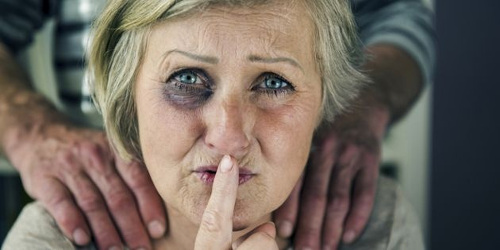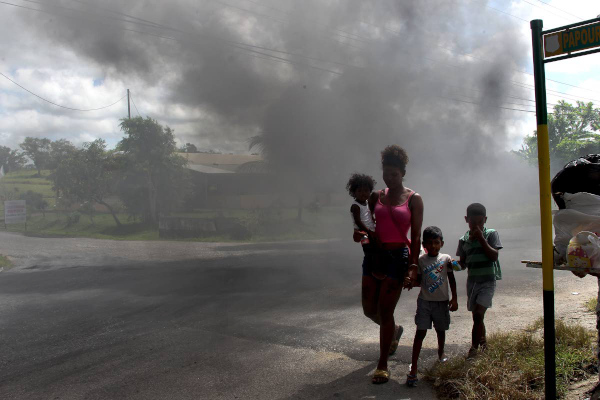“The latest research shows that men trace their right to beat women to patriarchal power over women, which they say, comes from religion and culture… Billions of—paid and unpaid—hours of training and education against domestic violence have not produced practical change.
“[…] Although individuals have transformed and there is less acceptance, the statistics remain the same because domestic violence is continuously transmitted in families and social structures.
“[…] Making it a men’s issue helps, and still misses the point. Transmission is interrupted by transformation in how we relate.”
The following letter written by Dr Catherine Ali is the fourth in a series of missives from the Coalition Against Domestic Violence, meant to raise awareness about the problem of violence against women and girls in Trinidad and Tobago:

(Copyright Yana Mazurkevich/Current Solutions)
Early in Trinidad and Tobago’s anti-domestic violence movement women like Nesta Patrick were stigmatised for lobbying for support and protection for women and children.
Incredulous men grappled with the shocking notion of public accountability for private life violence, particularly with an intimate partner. NGOs and professional women lobbied for legislation; but, once achieved, the legal approach even with stiffer penalties “to make men feel” didn’t work.
Women with restraining orders were beaten, killed and blamed for driving men to acts of violence.
The loss of male identity—meaninglessness, becoming nothing—triggered cycles of chaos that made murder-suicide and family genocide seem more desirable than existing without a woman, children, or family relations.
Vigils, walks, media campaigns, family services, the mediation movement, Hal Greaves’ School for Tabanca, male groups, extensive police training, and social media public awareness drives followed.
Today where are we? One in every three women, locally and globally, experiences violence. Only 7.5 per cent report the offence. Only 2 per cent use a hotline.

The latest research shows that men trace their right to beat women to patriarchal power over women, which they say, comes from religion and culture. Academic research, both local and global, demonstrates this. Billions of—paid and unpaid—hours of training and education against domestic violence have not produced practical change.
Why does the practice persist after many decades of work for change?
Although individuals have transformed and there is less acceptance, the statistics remain the same because domestic violence is continuously transmitted in families and social structures.
“What we resist persists” is true of work against domestic violence. Making it a men’s issue helps, and still misses the point. Transmission is interrupted by transformation in how we relate.
Tenderness, the connective tissue between the heart and the love energy we transmit to those we care about, can be strengthened and prioritised. Cultivating tenderness at critical points outmanoeuvres predatory behaviour.
While babies are developing, parents can interact and bond-relate—talk, sing, dream—in the months before birth. Cultivating an interactive relationship at this tender stage of total dependence has been shown to be an antidote to child abuse and domestic violence. The bond is so significant, so primal, it transforms persistent inter-generational pain.
It is a better way for new citizens to begin life. It generates greater participation of both parents and more equal and tender gender family relationships.

Want to share your thoughts with Wired868? Email us at editor@wired868.com.
Please keep your letter between 300 to 600 words and be sure to read it over first for typos and punctuation.
We don’t publish anonymously unless there is a good reason, such as an obvious threat of harassment or job loss.
 Wired868 Wired868 for smart sport news and opinion
Wired868 Wired868 for smart sport news and opinion







^^ lol
Don’t tell me he created his own blindspot to attack. Lemme check…
Where’s the line in the article that says 1 in 2?
“It is gender feminism which has helped undermine that bond by denigrating marriage and motherhood as laudable life goals for women and by demonising men by asserting (again, falsely) that the home is the most dangerous place for women.”
Really? Feminists denigrate marriage and motherhood?
I admit that I don’t closely follow the feminist movement but I never got that impression. My feeling was that they fought for choice, which is not the same thing.
Your impression is based on their PR not their manifest performance.
Lasana, see my response to this specific point (somewhere) above
You onlyt think so, Lasana, because you have fallen for their propaganda (as I had, until I actually started reading the founders of Third Wave feminism). When you look at the their actual core beliefs and recommended policies, you will see that the agenda is opposed to men as a sex in myriad ways, and certainly towards marriage.
Perfect example of specious claims from a gender feminist.
First of all, 1 in 2 women? even the highest ratios, from the World Health Organisation and the 2017 National Women’s Health Survey, claim no more than 1 in 3 women – and that statistic needs to be hedged by loose definitions of domestic violence and flawed methodologies – eg, when a woman who initiates violence by, say, slapping her partner, if he responds by pushing her back, she is still classified in these surveys as a DV victim.
Ms Ali goes on to claim “men trace their right to beat women to patriarchal power over women”. This implies that her 50 percent of women are being beaten by men, which is simply false; moreover, every opinion survey on this issue shows that the majority of men do not think it acceptable to hit women. Also, if DV is outcome of the so-called “patriarchy”, why is domestic abuse higher among gay couples, including lesbians?
Ms Ali’s point about parental bonding being a factor in reducing domestic violence is, broadly speaking, true. However, it is gender feminism which has helped undermine that bond by denigrating marriage and motherhood as laudable life goals for women and by demonising men by asserting (again, falsely) that the home is the most dangerous place for women.
https://www.cdc.gov/violenceprevention/pdf/cdc_nisvs_victimization_final-a.pdf
I have put this link up several times and, hilariously people shy away from commenting on the data.
I don’t know what TnT’s stats are but having worked 6 years analyzing certain data in TnT I have little confidence in our data collection and analytical ability.
The CDC stats show that only focusing on female victimization in heterosexual couples result in skewed view of the issues of IPV.
CDC 2010 stats show the following:
1) Women are more likely to be victim when in a relationship with women.
2) Men are more likely to be victim in relationship with women.
3) Men are safer in relationships with men
4) Regardless of sex once in an IP relationship at least 25% will report IPV
Chups
Wendell as a brother and friend, May I suggest that you be at least open to “listening” to these perspectives. Even as you have another take on the issue, please open your hearts to hearing that view shared by Dr Ali and others. It is the view of many of our mothers, sisters, wives and friends. To be understood and heard start by understanding and hearing. Just a thought.
Brian Harry i represent the resistance … enough already i wrote several versions of this response but in the end the original posting captures my sentiments…chups
Wendell Raeburn, do you disagree that violence against women is an issue?
Nigel Noel i have made this point ad nauseam … violence is a problem period! 68% of all acts of violence are against men. In simpler terms most affected demographic is male yet men run around the issue somehow believing that the issue is mainly female when it is clearly not. If you re read the first line of this article in with this in mind you will appreciate the absurdity of the articles premise…
I saw your exchange the last time as well, i guess my point is violence by men against men is an issue but also is violence by men against women.
To my simplistic mind these issues can be tackled separately as there are alot of men who would never instigate a fight with another man who routinely hit the women in their lives.
Thus shouldn’t we explore the reasons for this and try to find solutions?
Nigel cowards always fight when they can harm with impunity. They are always choosing weaker targets. This is true of male cowards, female cowards and children. To continue to follow the false narrative that “men” are the ones with a problem is to perpetuate the myth. The reality is emasculation in males can lead to a violent retaliation just as an assault on a woman’s sense of self can lead to a femme fatale. Our error is the idea that feminism is true to women’s good. Feminism is a tool of the elite to divide males and females to create situations that continue their ability to exploit the divisions and keep labor from seeing underpaying employers for the white collar criminals they are.
Feminism is a belief system that says women are not less than men.
How that is bad for women is beyond me.
Feminism is bad for men who believe they should continue being dominant over women.
Anyone who is inflicting harm/hurt on another person has a problem.
Why some people are so resistant to focusing on gender-based Violence is mystifying… (well not really… it just shows up their misogyny) Women are disproportionately affected by gender based violence. That’s why there’s an international campaign every year to spotlight the issue.
The majority of people affected by gang violence are men… which is why when activists are doing anti-gang work, they target boys more than girls.
How is this complicated to understand?
Feminism had those goals when they were suffragettes. When the name changed so too did the objective to division. You are still enraptured with a historical romantic perspective that has long been lost.
The suffragettes? Meaning you think gender equality was achieved when women earned the right to vote? LOL!!
Look…steups.
Feminism is a belief system that has not changed.
It is a movement made up of millions of people with different ideas regarding the best methods to realize the dream.
The perpetrators of this ill (us men mainly) require structured rehabilitation programs and re-education on roles and functions as a man and how to treat family.
Chabeth is there rehabilitation that is done here?
As far as I know, not in the sense of drug rehabilitation. But there are a number of men who run various groups and NGOs focusing on men’s issues and I know definitions of masculinity is something that is discussed as well as anger towards women.
But we are only now starting to evolve out of a victim blaming mentality with regard to gender based crimes, so I expect that over the next year or so, we will address perpetrators and their counseling and rehabilitation in a different way.
Chabeth, it maybe in the pipe-works, however one year may not be enough time for this to come to full fruition, it may need legislation and well supported institutions. Us men was not well cultured to speak openly on issues far-less for speaking on our abusive outbursts. Re-socialization is key on how and what we communicate.
We men were not well cultured – correction.
The interesting thing about domestic violence is that the programs that has been put into place over the years has been designed to empower the victims viz a viz women and children.